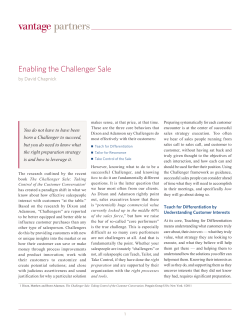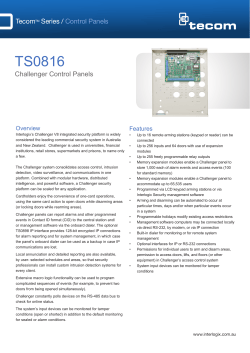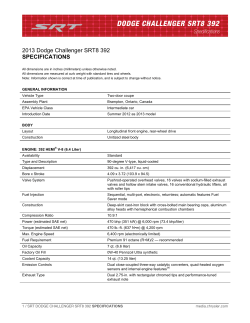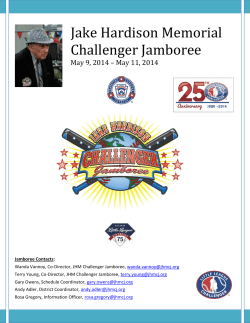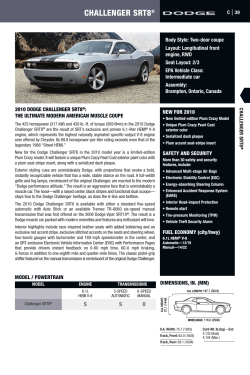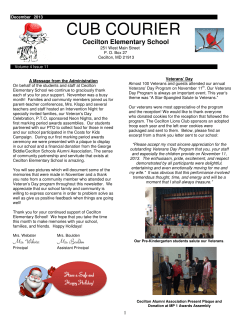
CHALLENGER SALE The Taking Control of the
MATTHEW DIXON and BRENT ADAMSON of Corporate Executive Board The CHALLENGER SALE Taking Control of the Customer Conversation “The most important advance in selling for many years.” —Neil Rackham, author of SPIN Selling The Challenger Sale Taking Control of the Customer Conversation Matthew Dixon and Brent Adamson Portfolio/Penguin 9781591844358_CHALLENGER.indb 3 9/7/11 10:09 AM portfolio / penguin Published by the Penguin Group Penguin Group (USA) Inc., 375 Hudson Street, New York, New York 10014, U.S.A. Penguin Group (Canada), 90 Eglinton Avenue East, Suite 700, Toronto, Ontario, Canada M4P 2Y3 (a division of Pearson Penguin Canada Inc.) Penguin Books Ltd, 80 Strand, London WC2R 0RL, England Penguin Ireland, 25 St. Stephen’s Green, Dublin 2, Ireland (a division of Penguin Books Ltd) Penguin Books Australia Ltd, 250 Camberwell Road, Camberwell, Victoria 3124, Australia (a division of Pearson Australia Group Pty Ltd) Penguin Books India Pvt Ltd, 11 Community Centre, Panchsheel Park, New Delhi – 110 017, India Penguin Group (NZ), 67 Apollo Drive, Rosedale, Auckland 0632, New Zealand (a division of Pearson New Zealand Ltd) Penguin Books (South Africa) (Pty) Ltd, 24 Sturdee Avenue, Rosebank, Johannesburg 2196, South Africa Penguin Books Ltd, Registered Offices: 80 Strand, London WC2R 0RL, England First published in 2011 by Portfolio / Penguin, a member of Penguin Group (USA) Inc. 1 3 5 7 9 10 8 6 4 2 Copyright © The Corporate Executive Board Company, 2011 All rights reserved Challenger™, Challenger Rep, and Challenger Development Program™ are trademarks and service marks of The Corporate Executive Board Company. ® Summary description of Situational Sales Negotiation training and methodology used by permission of BayGroup International, Inc. SSN Negotiation Planner ™ and © 2009 BayGroup International, Inc. Situational Sales Negotiation and SSN ™ are trademarks and service marks of BayGroup International, Inc. ® Slides from “The Power of Planning the Unplanned” presentation used by permission of W. W. Grainger, Inc. library of congress cataloging in publication data Dixon, Matthew, 1972. The challenger sale : taking control of the customer conversation / Matthew Dixon and Brent Adamson. p. cm. Includes index. ISBN 978-1-59184-435-8 1. Sales management. 2. Selling. 3. Customer relations. I. Adamson, Brent. II. Title. HF5438.4.D59 2011 658.85—dc23 2011026907 Printed in the United States of America Set in Adobe Garamond Pro Designed by Pauline Neuwirth Without limiting the rights under copyright reserved above, no part of this publication may be reproduced, stored in or introduced into a retrieval system, or transmitted, in any form or by any means (electronic, mechanical, photocopying, recording or otherwise), without the prior written permission of both the copyright owner and the above publisher of this book. The scanning, uploading, and distribution of this book via the Internet or via any other means without the permission of the publisher is illegal and punishable by law. Please purchase only authorized electronic editions and do not participate in or encourage electronic piracy of copyrightable materials. Your support of the author’s rights is appreciated. 9781591844358_CHALLENGER.indb 4 9/7/11 10:09 AM Contents Foreword by Professor Neil Rackham ix Introduction A Surprising Look into the Future 1 The Evolving Journey of Solution Selling 1 5 2 The Challenger (Part 1): A New Model for High Performance 14 3 The Challenger (Part 2): Exporting the Model to the Core 30 4 Teaching for Differentiation (Part 1): Why Insight Matters 44 5 Teaching for Differentiation (Part 2): How to Build Insight-Led Conversations 65 6 Tailoring for Resonance 101 7 Taking Control of the Sale 119 8 The Manager and the Challenger Selling Model 140 9 Implementation Lessons from the Early Adopters 170 • vii 9781591844358_CHALLENGER.indb 7 9/7/11 10:09 AM Afterword viii • Challenging Beyond Sales 187 Acknowledgments 197 Appendix A: Challenger Coaching Guide (excerpt) 205 ppendix B: A Selling Style Self-Diagnostic 208 Appendix C: Challenger Hiring Guide: Key Questions to Ask in the Interview 210 Index 215 contents 9781591844358_CHALLENGER.indb 8 9/7/11 10:09 AM Foreword The history of sales has been one of steady progress interrupted by a few real breakthroughs that have changed the whole direction of the profession. These breakthroughs, marked by radical new thinking and dramatic improvements in sales results, have been rare. I can only think of three of them in the last century. The first started about a hundred years ago, when insurance companies found that they could double their sales by a simple change in selling strategy. Before this first great breakthrough, insurance policies—in common with many other products such as furniture, household goods, and capital equipment—were sold by salespeople who signed up customers and then every week visited each of them to collect premiums or installment payments. After signing up a hundred or so people, the salesperson was too busy collecting weekly premiums to do any more selling of new business. Then some anonymous genius hit on an idea that grew into what we now call the hunter-farmer model. Suppose, instead of one person both selling the policy and collecting the premiums, the two roles were split. There would be producers, who only sold, backed up by less experienced—and therefore cheaper—collectors, • ix 9781591844358_CHALLENGER.indb 9 9/7/11 10:09 AM who came behind to look after existing customers and collect the weekly premiums. The idea was a spectacular success and it changed the insurance industry overnight. The concept quickly spread to other industries, and for the first time selling became a “pure” role, without the burden of collection. The Second Breakthrough We don’t know exactly when the producer/collector idea was first introduced, but we can be very specific about the date of the second great breakthrough. It happened in July 1925, when E. K. Strong published The Psychology of Selling. This seminal work introduced the idea of sales techniques, such as features and benefits, objection handling, closing, and, perhaps most important, open and closed questioning. It showed that there were things people could learn that would help them sell more effectively, and it gave rise to the sales training industry. Looking back from the sophisticated perspective of today, many of the things Strong wrote about sound heavy-handed and simplistic. Nevertheless, he—and those who followed him—changed selling forever. Perhaps the most important aspect of his contribution was the idea that selling wasn’t an innate ability. It was a set of identifiable skills that could be learned. And in 1925, that was radical indeed. It opened selling to a much wider range of people and, from anecdotal reports of the time, brought about dramatic increases in sales effectiveness. The Third Breakthrough The third great breakthrough came in the 1970s, when researchers became interested in the idea that the techniques and skills that worked in small sales might be very different from those that worked in larger and more complex ones. I had the good fortune to be an integral part of this revolution. In the ’70s I directed a huge research project, tracking 10,000 salespeople in twenty-three countries. We followed salespeople into more than 35,000 sales calls and analyzed what made some x • foreword 9781591844358_CHALLENGER.indb 10 9/7/11 10:09 AM of them more successful than others in complex sales. From this twelveyear project we published a number of books, starting with SPIN Selling. This marked the beginning of what we now call the consultative selling era. It was a breakthrough because it introduced much more sophisticated models of how to sell complex products and services and, like the earlier breakthroughs, brought about significant gains in sales productivity. The last thirty years have been marked by a lot of small improvements in selling, but we haven’t seen many game-changing developments that could claim to be breakthroughs. True, there’ve been sales automation, sales process, and customer relationship management. Technology has played a bigger and bigger role in selling. There have also been huge changes to transactional selling as a result of the Internet. But all these have been incremental changes, often with questionable productivity gains, and none of them, to my way of thinking, qualifies as a bona fide breakthrough in how to sell differently and more effectively. The Purchasing Revolution Interestingly, there has been a breakthrough development on the other side of the selling interaction. Purchasing has gone through a major revolution. From being a dead-end function in the 1980s where those who couldn’t cut it in HR went to die, it has emerged as a vibrant strategic force. Armed with powerful purchasing methodologies such as supplier segmentation strategies and sophisticated supply chain management models, the rise of the new purchasing has demanded fundamental shifts in sales thinking. I’ve been waiting to see how the sales world would react to the changes in purchasing. If ever there was a time for the next breakthrough, it’s due in response to the purchasing revolution. But nothing big has appeared on the sales scene. It’s been a bit like waiting for the inevitable earthquake. You know it’s going to come someday, but you can’t predict when—you just have a feeling that it’s due; something is about to happen. foreword 9781591844358_CHALLENGER.indb 11 • xi 9/7/11 10:09 AM The Fourth Breakthrough? Which brings me to The Challenger Sale and the work of the Sales Executive Council. It’s too soon to know whether this is the breakthrough that we’ve been waiting for: Only time will tell. On the face of it, their research has all the initial signs that it may be game-changing. First, like the other examples, it flies in the face of conventional wisdom. But we need more than that. Many crazy ideas violate established thinking. What makes this different is that, like the other breakthroughs, once sales leaders understand it, they say, “Of course! It’s counterintuitive, but it makes sense. I should have known.” The logic you’ll find in The Challenger Sale leads to the inescapable conclusion that this is very different thinking and it works. I’m not going to spoil their story by telling either the details or the punch line. That’s for you to read. But I will tell you why I think the research that they have done is the most important advance in selling for many years and may indeed justify the rare and coveted label of “sales breakthrough.” It’s Good Research The research is solid, and believe me, I don’t say this lightly. Much of the so-called research in selling has methodological holes so big that you could fly a jumbo jet through them. We live in an age when every consultant and every author claims “research” to prove the effectiveness of what they are selling. Once research was a sure way to gain credibility; now it’s fast becoming a sure way to lose it. Customers are rightly cynical about unsupportable claims that masquerade under the name of research, such as, “Our research proves that sales more than doubled after taking our training program,” or “We found in our research that when salespeople used our seven customer buying styles model, it caused customer satisfaction to increase by 72 percent.” Claims like these are unprovable assertions that erode the credibility of genuine research. I was at a conference in Australia when I first heard that the Sales Executive Council had some startling new research on sales effectiveness. xii • foreword 9781591844358_CHALLENGER.indb 12 9/7/11 10:09 AM I must admit that, while I respected the SEC and their good track record of solid methodology, I had been bitten enough by poor research to think to myself, “This will probably be yet another disappointment.” When I got back to my office in Virginia, I invited the research team to spend a day with me and we went through their methodology with a fine-tooth comb. I admit that I confidently expected to expose serious flaws in what they had done. In particular, I had two concerns: 1. Putting salespeople into five buckets. The research claimed that salespeople fell into one of five distinct profiles: The Hard Worker The Challenger The Relationship Builder The Lone Wolf The Reactive Problem Solver This sounded naïve and arbitrary to me. What, I asked the team, was the rationale for these five buckets? Why not seven? Or ten? They were able to show me that these were not invented categories but ones that emerged out of a massive and sophisticated statistical analysis. And they understood, in a way that many researchers don’t, that their five buckets were behavioral clusters, not rigid personality types. I was satisfied that they had passed my first test. 2. The high- versus low-performer trap. A large percentage of the research into effective selling compares high performers with low performers. In the early years of my own research I did the same thing. As a result I learned a lot about low performers. When you ask people to compare their rock stars with their losers, you find that they can dissect the losers with surgical precision but find it hard, if not impossible, to put their finger on exactly what makes their rock stars rock. I soon learned that I ended up with a detailed understanding of poor performance and not much else. If my research was to have any meaning I had to compare top performers with average, or core, performers. It was reassuring to find that the SEC research had adopted exactly that approach. foreword 9781591844358_CHALLENGER.indb 13 • xiii 9/7/11 10:09 AM It’s Based on an Impressive Sample It’s common for sales research to be based on small samples of fifty to eighty participants drawn from just three or four companies. Larger-scale research is harder to do and significantly more expensive. My own research had used samples of a thousand or more, not because we liked megastudies but because—given the noisy data of real-life selling—we had no choice if we wanted to draw statistically meaningful insights. The initial sample in the Challenger research was 700, which has since grown to 6,000. That’s impressive by any standard. What’s even more impressive is that ninety companies participated in the research. With a sample this wide we can rule out many of the factors that normally prevent research from generalizing its results to cover selling as a whole. The SEC findings are not about a particular organization or a specific industry. They apply across the whole spectrum of selling, and that’s important. It Didn’t Find What the Researchers Expected I always mistrust research that finds exactly what it seeks. Researchers, like everybody else, have a bundle of prejudices and preconceived ideas. If they know what they are looking for, by gosh they will find it. I was really pleased to hear that the researchers themselves were stunned to discover that their results were almost the opposite of what they had expected. That’s a very healthy sign and a frequent characteristic of significant research. Look again at their five profiles: The Hard Worker The Challenger The Relationship Builder The Lone Wolf The Reactive Problem Solver Most sales executives, if they were forced to choose just one profile to make up their sales force, would have chosen the Relationship Builder, and that’s just what the research team was expecting to find. Think again. The research showed that Relationship Builders were unlikely to xiv • foreword 9781591844358_CHALLENGER.indb 14 9/7/11 10:09 AM be star performers. In contrast, the Challengers, who are awkward to manage and assertive both with customers and with their own managers, came out on top. As you’ll see in the book, Challengers won out not by a small margin but a massive one. And the margin was far greater in complex sales. The Decline of Relationship Selling How can we explain these counterintuitive findings? In the book, Matt Dixon and Brent Adamson build a very persuasive case. Let me add my own two cents’ worth to what they say. Conventional wisdom has long held that selling is about relationships and that in complex sales, relationships are the underpinning of all sales success. Yet over the last ten years there have been some disturbing hints that relationship-based selling may be less effective than it used to be. My own studies of what customers value from salespeople would be a good example. When we asked 1,100 customers what they valued in salespeople, we were surprised at how few times they mentioned relationships. It seems that the old advice, “Build relationships first and then sales will follow,” no longer holds true. That’s not to say that relationships are unimportant. I think a better explanation is that the relationship and the purchasing decision have become decoupled. Today you’ll often hear customers say, “I have a great relationship with this sales rep but I buy from her competition because they provide better value.” Personally, I believe that a customer relationship is the result and not the cause of successful selling. It is a reward that the salesperson earns by creating customer value. If you help customers think differently and bring them new ideas—which is what the Challenger rep does—then you earn the right to a relationship. The Challenge of Challenge At the heart of this book is the demonstrated superiority of Challengers in terms of customer impact and therefore sales results. Many people foreword 9781591844358_CHALLENGER.indb 15 • xv 9/7/11 10:09 AM are taken aback by this finding—and I suspect some readers will feel the same. But while the articulation of the Challenger idea is new, the evidence has been visible all around us. Surveys of customers consistently show that they put the highest value on salespeople who make them think, who bring new ideas, who find creative and innovative ways to help the customer’s business. In recent years, customers have been demanding more depth and expertise. They expect salespeople to teach them things they don’t know. These are the core skills of Challengers. They are the skills of the future, and any sales force that ignores the message of this book does so at its peril. I’ve been in the business of sales innovation all my professional life, so I don’t anticipate that the publication of this important research will bring an instant revolution. Change is slow and painful. But I do know this: There will be a few companies that will take the findings that are laid out here and will implement them well. Those companies will reap huge gains and significant competitive advantage from building Challenge into their sales force. As the SEC research shows, we live in an era when product innovation alone cannot be the basis for corporate success. How you sell has become more important than what you sell. An effective sales force is a more sustainable competitive advantage than a great product stream. This book gives you a well-articulated blueprint for building a winning sales force. My advice is this: Read it, think about it, implement it. You, and your organization, will be glad that you did. Professor Neil Rackham Author of SPIN Selling xvi • foreword 9781591844358_CHALLENGER.indb 16 9/7/11 10:09 AM Introduction A Surprising Look into the Future In the unforgettable early months of 2009, as the bottom fell out of the global economy, business-to-business sales leaders around the world faced an epic problem and an even deeper mystery. Customers had vanished overnight. Commerce had ground to a halt. Credit was scarce, and cash even scarcer. For anyone in business, times were tough. But for heads of sales, they were an absolute nightmare. Imagine having to get up every morning, rally your troops, and send them into a battle they couldn’t possibly win. To find business where none could be found. True, sales has always been about the good fight— about winning business often in the face of strong resistance. But this was different. It’s one thing to sell to reluctant, even nervous customers. It’s another thing altogether to sell to no one at all. And that’s where we were in early 2009. Yet therein lay the mystery. Staring directly into the teeth of the toughest sales environment in decades—if not ever—a small but uniquely gifted number of sales reps were selling. In fact, they were selling a lot. While others struggled to close even the smallest of deals, these individuals were bringing in the kind of business most reps could only • 1 9781591844358_CHALLENGER.indb 1 9/7/11 10:09 AM dream of even in an up economy. Were they lucky? Were they just born with it? And most important, how could you possibly capture that magic, bottle it, and export it to everyone else? For many companies, their very survival depended on the answer. It was into this environment that the Sales Executive Council (SEC)— a program within the Corporate Executive Board—launched what has become one of the most important studies of sales rep productivity in decades. Tasked by our members—heads of sales from the world’s largest, best-known companies—we set out to identify what exactly set this very special group of sales reps apart. And having now studied that question intensively for the better part of four years, spanning dozens of companies and thousands of sales reps, we have discovered three core insights that have fundamentally rewritten the sales playbook and led B2B sales executives all over the world to think very differently about how they sell. The first insight was something we weren’t originally even looking for. It turns out that just about every B2B sales rep in the world falls into one of five distinct profiles, a specific set of skills and behaviors that define his or her primary mode of interacting with customers. Now, that’s interesting in and of itself, as you’ll be able to find yourself and your colleagues in these profiles when you see them. These five profiles prove to be an incredibly practical way of dividing the world into a manageable set of alternative sales techniques. That said, it’s really the second insight that changes everything. When you take those five profiles and compare them with actual sales performance, you find there is a very clear winner and a very clear loser: One of them spectacularly outperforms the other four, while one of them falls dramatically behind. Yet there is something very disturbing about these results. When we show them to sales leaders, we hear the same thing again and again. These leaders find the results deeply troubling, because they’ve placed by far their biggest bet on the profile least likely to win. This one insight has shattered the way many sales leaders think about the kind of reps they need to survive and thrive in a tough economy. And that brings us to the third and final core insight from this work— arguably the most explosive of them all. As we dug deeper into the data, 2 • T h e C h a l l e n g e r Sa l e 9781591844358_CHALLENGER.indb 2 9/7/11 10:09 AM we found something even more surprising. While we’d set out four years ago to find the winning recipe for sales rep success in a down economy, all of the data indicate something far more important. The profile most likely to win isn’t winning because of the down economy, but irrespective of it. These reps are winning because they’ve mastered the complex sale, not because they’ve mastered a complex economy. In other words, when we unlocked the mystery of high performance in the down economy, the story turned out to be much bigger than anyone had anticipated. Your very best sales reps—the ones who carried you through the downturn— aren’t just the heroes of today, but are also the heroes of tomorrow, as they are far better able to drive sales and deliver customer value in any kind of economic environment. What we ultimately found is a dramatically improved recipe for a successful solution sales rep. We call these winning reps Challengers, and this is their story. I n t r o d u c t i o n : A S u r p r i s i n g L o ok I n t o t h e F u t u r e 9781591844358_CHALLENGER.indb 3 • 3 9/7/11 10:09 AM
© Copyright 2025
